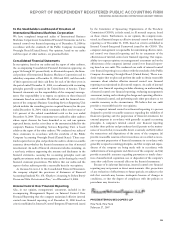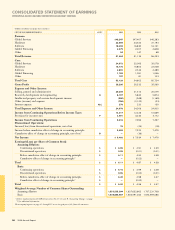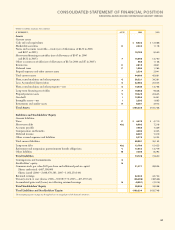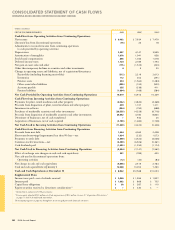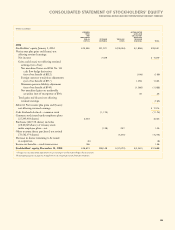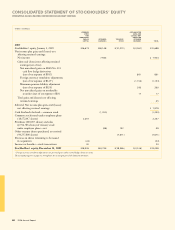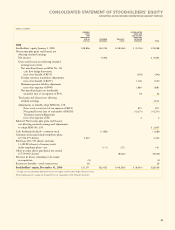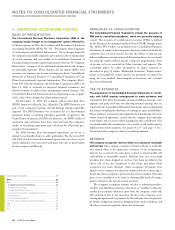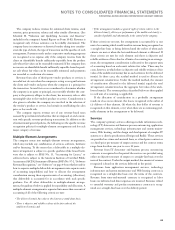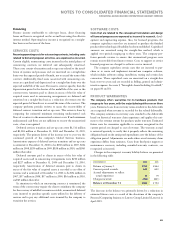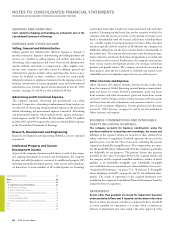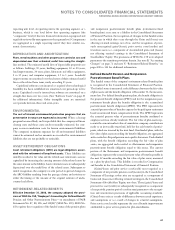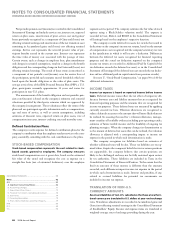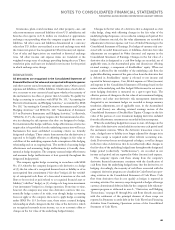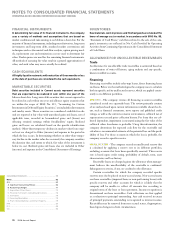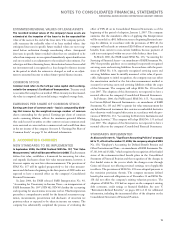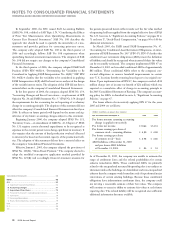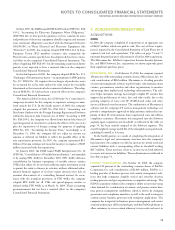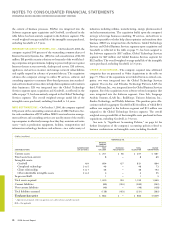IBM 2006 Annual Report Download - page 66
Download and view the complete annual report
Please find page 66 of the 2006 IBM annual report below. You can navigate through the pages in the report by either clicking on the pages listed below, or by using the keyword search tool below to find specific information within the annual report.
Revenue from fixed-price Design and Build contracts is recog-
nized in accordance with SOP No. 81-1, “Accounting for Performance
of Construction-Type and Certain Production-Type Contracts,”
under the percentage-of-completion (POC) method. Under the
POC method, revenue is recognized based on the costs incurred to
date as a percentage of the total estimated costs to fulfill the contract.
If circumstances arise that change the original estimates of revenues,
costs, or extent of progress toward completion, revisions to the esti-
mates are made. These revisions may result in increases or decreases
in estimated revenues or costs, and such revisions are reflected in
income in the period in which the circumstances that give rise to the
revision become known by management. While the company uses the
POC method as its basic accounting policy under SOP 81-1, the
company uses the completed-contract method if reasonable estimates
for a contract or group of contracts cannot be developed.
The company performs ongoing profitability analyses of its ser-
vices contracts accounted for under the POC method in order to
determine whether the latest estimates of revenue, costs and profits
require updating. If at any time these estimates indicate that the
contract will be unprofitable, the entire estimated loss for the remain-
der of the contract is recorded immediately. For non-POC services
contracts, losses are recorded as incurred.
In some of the company’s services contracts, the company bills the
client prior to recognizing revenue from performing the services.
Deferred income of $5.0 billion and $4.3 billion at December 31,
2006 and 2005, respectively, is included in the Consolidated Statement
of Financial Position. In other services contracts, the company per-
forms the services prior to billing the client. Unbilled accounts
receivable of $1.8 billion and $1.7 billion at December 31, 2006 and
2005, respectively, are included in Notes and accounts receivable-
trade in the Consolidated Statement of Financial Position. Billings
usually occur in the month after the company performs the services
or in accordance with specific contractual provisions. Unbilled
receivables are expected to be billed and collected within four
months, rarely exceeding nine months.
Hardware
Revenue from hardware sales and sales-type leases is recognized
when risk of loss has transferred to the client and there are no unful-
filled company obligations that affect the client’s final acceptance of
the arrangement. Any cost of standard warranties and remaining
obligations that are inconsequential or perfunctory are accrued when
the corresponding revenue is recognized. Revenue from rentals and
operating leases is recognized on a straight-line basis over the term
of the rental or lease.
Software
Revenue from perpetual (one-time charge) license software is recog-
nized at the inception of the license term if all revenue recognition
criteria have been met. Revenue from term (recurring license charge)
license software is recognized on a subscription basis over the period
that the client is entitled to use the license. Revenue from maintenance,
unspecified upgrades on a when-and-if-available basis and technical
support is recognized over the period such items are delivered. In
multiple-element revenue arrangements that include software that is
more than incidental to the products or services as a whole (software
multiple-element arrangements), software and software-related ele-
ments are accounted for in accordance with the following policies.
Software-related elements include software products and services, as
well as any non-software deliverable for which a software deliverable
is essential to its functionality.
A software multiple-element arrangement is separated into more
than one unit of accounting if all of the following criteria are met:
• The functionality of the delivered element(s) is not dependent on the
undelivered element(s);
• There is vendor-specific objective evidence ( VSOE) of fair value of the
undelivered element(s). VSOE of fair value is based on the price charged
when the deliverable is sold separately by the company on a regular
basis and not as part of the multiple-element arrangement; and
• Delivery of the delivered element(s) represents the culmination of the
earnings process for that element(s).
If these criteria are not met, the arrangement is accounted for as one
unit of accounting which would result in revenue being recognized on
a straight-line basis or being deferred until the earlier of when such
criteria are met or when the last undelivered element is delivered. If
these criteria are met for each element and there is VSOE of fair value
for all units of accounting in an arrangement, the arrangement con-
sideration is allocated to the separate units of accounting based on
each unit’s relative VSOE of fair value. There may be cases, however,
in which there is VSOE of fair value of the undelivered item(s) but no
such evidence for the delivered item(s). In these cases, the residual
method is used to allocate the arrangement consideration. Under the
residual method, the amount of consideration allocated to the deliv-
ered item(s) equals the total arrangement consideration less the
aggregate VSOE of fair value of the undelivered elements.
NOTES TO CONSOLIDATED FINANCIAL STATEMENTS
INTERNATIONAL BUSINESS MACHINES CORPORATION AND SUBSIDIARY COMPANIES
64 2006 Annual Report
Consolidated Statements .........................................................
Notes .....................................................................................
A-G .........................................................................................
A. Significant Accounting Policies .......................................
B. Accounting Changes........................................................
C. Acquisitions/Divestitures .................................................
D. Financial Instruments (excluding derivatives) ................
E. Inventories .......................................................................
F. Financing Receivables ......................................................
G. Plant, Rental Machines and Other Property ...................
H-M .........................................................................................
N-S ..........................................................................................
T-X ..........................................................................................
Black
MAC
390 CG10



